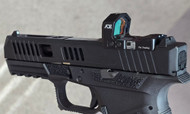Red Dot vs. Iron Sights: Which Optic is Right for Your Pistol?
Posted by Arms Protection on Oct 24th 2025
For decades, the standard three-dot iron sight system reigned supreme on pistols. Today, however, miniaturized red dot sights (RDS) have become a massive force, moving rapidly from niche competition gear to standard equipment for concealed carry and home defense. Choosing between the traditional and the modern can be tricky. This guide breaks down the pros and cons of each to help you decide.
The Classic Choice: Iron Sights
Iron sights utilize a simple alignment system—typically aligning a front post with two rear notches. They are rugged, reliable, and require no batteries.
Pros of Iron Sights:
- Durability: They are virtually indestructible and cannot fail due to electronics or battery depletion.
- Familiarity: Most new shooters begin with iron sights, making them instantly accessible.
- Cost-Effective: Standard sights are included with the pistol, offering the most budget-friendly solution.
- Zero Maintenance: No need to worry about power, adjustments, or cleaning lenses.
Cons of Iron Sights:
- Slower Sight Picture: Requires aligning three distinct objects (rear sight, front sight, target).
- Target Focus Disadvantage: When aligning the sights, the target will naturally be blurry.
- Reduced Low-Light Capability: Requires tritium or fiber-optic enhancements for visibility in darkness.
The Modern Standard: Red Dot Sights (RDS)
A pistol red dot projects a brightly illuminated aiming point onto a lens, allowing the shooter to aim with both eyes open and focusing only on the target.
Pros of Red Dot Sights:
- Faster Target Acquisition: Once trained, shooters can find the single dot faster than aligning three points.
- Target Focus: The shooter keeps their focus on the threat/target, leading to greater awareness and precision.
- Improved Low-Light Performance: The illuminated reticle is highly visible in all lighting conditions.
- Easier for Shooters with Poor Eyesight: Eliminates the need to perfectly focus on the small iron sights.
Cons of Red Dot Sights:
- Cost & Mounting: Initial investment is higher, and the pistol often requires specific slide cuts for mounting.
- Electronics: Requires batteries and can fail due to impact or electronic issues.
- Learning Curve: Finding the dot consistently under pressure requires significant training and practice.
- "Dot Bloom": Shooters with astigmatism may see a starburst or fuzzy shape instead of a crisp dot.
The Verdict: Which Should You Choose?
The best choice comes down to your primary use, budget, and commitment to training.
- For the New Shooter or Tight Budget: Start with quality Iron Sights. They build fundamental shooting mechanics without the distraction or cost of electronics.
- For Concealed Carry & Advanced Users: Invest in a quality Red Dot Sight. The speed and target-focused advantage they offer in high-stress defense scenarios are arguably unmatched.
Pro Tip: If you choose a red dot, always ensure your pistol has co-witnessed iron sights (sights visible through the optic window). This provides a vital backup in case of electronic failure.

